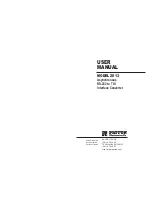
4-179
PID Tuning
Use the following procedures to enable PID control:
(1) Enable PID control (set 10-03 to a value greater than "xxx0b").
(2) Increase the proportional gain (10-05) to the highest value possible without causing the system to become
unstable.
(3) Decrease the integral time (10-06) to the lowest value possible without causing the system to become
unstable.
(4) Increase the differential time (10-07) to the highest value possible without causing the system to become
unstable.
The PID control serves to maintain a given process within certain limits whether it is pressure, flow etc. To do this
the
feedback
signal is compared to the
set value
and the difference becomes the error signal for the PID control.
The PID control then responds by trying to minimize this error. The error is multiplied times the value of the
Proportional gain
set by parameter
10-05
. An increased gain value results in a larger error. However, in any
system as the gain is increased there is a point that the system will become unstable (oscillate).
To correct this instability, the response time of the system may be
slowed
down by increasing the
Integral time
set by parameter
10-06
. However slowing the system down too much may be unsatisfactory for the process.
The end result is that these two parameters in conjunction with the acceleration time (01-14) and deceleration
(
01-15
) times require to be adjusted to achieve optimum performance for a particular application.
PID output polarity can be selected with parameter 10-03 (setting = xx0xb: PID output forward, setting = xx1xb:
PID output reversal). When PID output is chosen to reverse, and if PID input is
negative
, the output frequency of
PID will gain.
On the contrary, PID output is chosen to forward, and if PID input is minus, the output frequency of
PID will decrease.
PID feedback value can be adjusted using parameter 10-04 (PID feedback gain) as well as with the analog input
gain and bias for terminal AI1 or AI2.
10-09
PID bias
Range
【
-100~100
】
%
Parameter used to adjust the offset of the PID control. The offset value is added to the frequency reference as
compensation. Use parameter 10-24 (PID output gain) to control the amount of compensation.
10-14
PID integral limit
Range
【
0.0~100.0
】
%
Parameter used to limit the integral output to prevent motor stall or damage to the system in case of a rapid
change in the feedback signal. Reduce the value of 10-14 to increase the inverter response.
10-23
PID limit
Range
【
0.00~100.0
】
%
Sets the PID output limit. Maximum output frequency is 100%.
















































